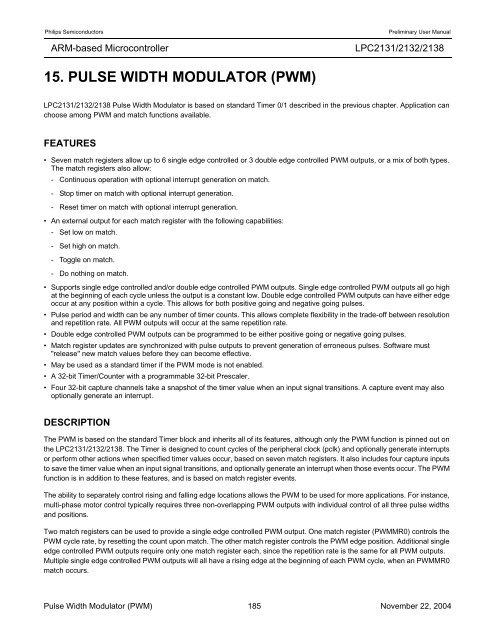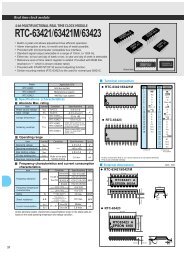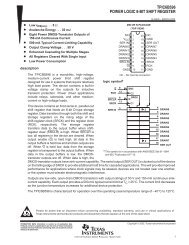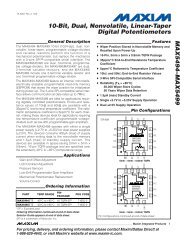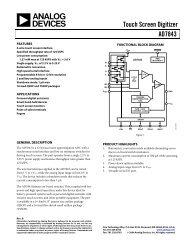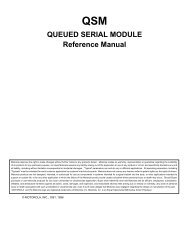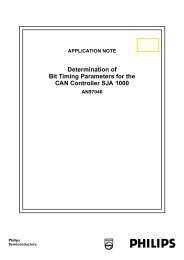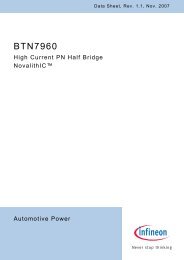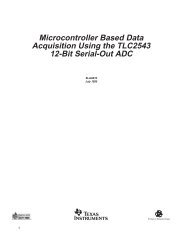Create successful ePaper yourself
Turn your PDF publications into a flip-book with our unique Google optimized e-Paper software.
Philips Semiconductors Preliminary <strong>User</strong> <strong>Manual</strong><br />
ARM-based Microcontroller<br />
15. PULSE WIDTH MODULATOR (PWM)<br />
<strong>LPC2131</strong>/<strong>2132</strong>/<strong>2138</strong><br />
<strong>LPC2131</strong>/<strong>2132</strong>/<strong>2138</strong> Pulse Width Modulator is based on standard Timer 0/1 described in the previous chapter. Application can<br />
choose among PWM and match functions available.<br />
FEATURES<br />
Seven match registers allow up to 6 single edge controlled or 3 double edge controlled PWM outputs, or a mix of both types.<br />
The match registers also allow:<br />
- Continuous operation with optional interrupt generation on match.<br />
- Stop timer on match with optional interrupt generation.<br />
- Reset timer on match with optional interrupt generation.<br />
An external output for each match register with the following capabilities:<br />
- Set low on match.<br />
- Set high on match.<br />
- Toggle on match.<br />
- Do nothing on match.<br />
Supports single edge controlled and/or double edge controlled PWM outputs. Single edge controlled PWM outputs all go high<br />
at the beginning of each cycle unless the output is a constant low. Double edge controlled PWM outputs can have either edge<br />
occur at any position within a cycle. This allows for both positive going and negative going pulses.<br />
Pulse period and width can be any number of timer counts. This allows complete flexibility in the trade-off between resolution<br />
and repetition rate. All PWM outputs will occur at the same repetition rate.<br />
Double edge controlled PWM outputs can be programmed to be either positive going or negative going pulses.<br />
Match register updates are synchronized with pulse outputs to prevent generation of erroneous pulses. Software must<br />
"release" new match values before they can become effective.<br />
May be used as a standard timer if the PWM mode is not enabled.<br />
A 32-bit Timer/Counter with a programmable 32-bit Prescaler.<br />
Four 32-bit capture channels take a snapshot of the timer value when an input signal transitions. A capture event may also<br />
optionally generate an interrupt.<br />
DESCRIPTION<br />
The PWM is based on the standard Timer block and inherits all of its features, although only the PWM function is pinned out on<br />
the <strong>LPC2131</strong>/<strong>2132</strong>/<strong>2138</strong>. The Timer is designed to count cycles of the peripheral clock (pclk) and optionally generate interrupts<br />
or perform other actions when specified timer values occur, based on seven match registers. It also includes four capture inputs<br />
to save the timer value when an input signal transitions, and optionally generate an interrupt when those events occur. The PWM<br />
function is in addition to these features, and is based on match register events.<br />
The ability to separately control rising and falling edge locations allows the PWM to be used for more applications. For instance,<br />
multi-phase motor control typically requires three non-overlapping PWM outputs with individual control of all three pulse widths<br />
and positions.<br />
Two match registers can be used to provide a single edge controlled PWM output. One match register (PWMMR0) controls the<br />
PWM cycle rate, by resetting the count upon match. The other match register controls the PWM edge position. Additional single<br />
edge controlled PWM outputs require only one match register each, since the repetition rate is the same for all PWM outputs.<br />
Multiple single edge controlled PWM outputs will all have a rising edge at the beginning of each PWM cycle, when an PWMMR0<br />
match occurs.<br />
Pulse Width Modulator (PWM) 185 November 22, 2004


